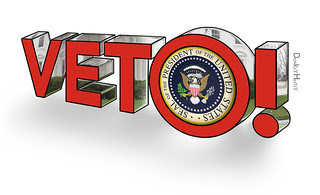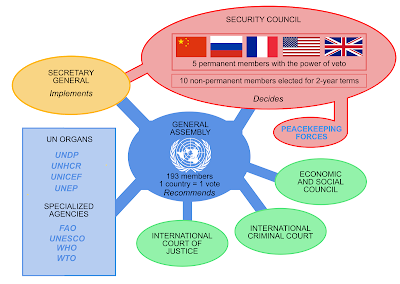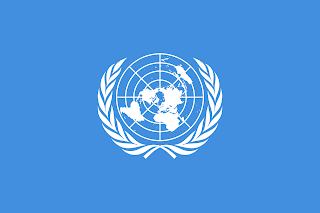What is ‘VETO POWER’?
'Veto' is a Latin word, and this means to register your
'disagreement' on any issue. In Ancient Rome, some elected officials had extra
power. They could stop any action of the Rome government by using these powers.
Since then, the word used to be used for the power to stop doing something.
usually with the special powers obtained by the five permanent members of the'United Nations Security Council'. These countries are America, Russia,
Britain, China and France. Any member of this can stop vetting any proposal in
the United Nations. This means that "for the resolution of any proposal in
the United Nations, these five countries should be cleared. None of them vetted
the proposal, and then the resolution will not be passed.
History of
In February, 1945 a conference was held in the city of
Yalta, Crimea, Ukraine. This conference was known as the Yalta Conference or
the Crimean Conference. At the same conference, the then Prime Minister of the
Soviet Union Joseph Stalin proposed Veto Power. The Yalta Conference was
organized to prepare for post-war planning. In this, UK Prime Minister Winston
Churchill, Prime Minister Joseph Stalin of Soviet Union and US President D.
Roosevelt took part. However, this concept of veto did not come in 1945. After
the establishment of the League of Nations in 1920, Vito Power came to existence.
At that time both the permanent and non-permanent members of the League Council
had veto power.
When the 'United Nations' was established, and why –
In order to know about the 'United Nations', we have to know
about the League of Nations, which was the same organization as the United
Nations that was operating before the United Nations was established. After the
break of 'League of Nations', the United Nations was established. The United
Nations is an altered form of the 'League of Nations'.
'League
of Nations' –
It was an intergovernmental organization which was born on
January 10, 1920, and came out as a result after the Paris Peace Conference
ended. The 'League of Nations' was established after World War I and it meant
that there was peace in the world and there would never be such a world war.
But this organization failed to do so and the world also suffered from World
War II. The members of the League Council from 1920 to 1946 had the power of
'veto' power even if it had only four of their four permanent and four
temporary members. In 1936, the number of temporary members of the 'League
Council' increased to 11 and with these 15 countries had 'veto' power. The main
reason for the failure of the 'League of Nations' was 'Veto' power..
First
time used
On February 16, 1946 the Union of Soviet Socialist Republics (USSR)
used Veto Power for the first time. USSR vetoed proposals for withdrawal of
foreign troops from Lebanon and Syria. Since that time the veto has been used
291 times.
Purpose
of veto-
The purpose of veto power is that it establishes security
and peace in the world and if the world poses a threat to peace, and then
considers it. It considers the complaint sent to any country and any disputes
like it help in resolving the related matter.
The real use of the veto, and the constant possibility of
its use, is the central characteristics of the Security Council during the
history of the United Nations. From 1945 to 2009, 215 proposals were vetted on
actual issues, sometimes more than one in P5. The average number of veto per
year was more than five in 1989: since then the average annual number was only
above one.
There has been discussion of the increase in the number of
permanent members. Countries which have made strongest demands for permanent
seats are Brazil, Germany, India and Japan. Japan and Germany are the second
and third largest funders of the United Nations, while Brazil, the largest
Latin American nation and India, the world's largest Democracy And the second
most populous country, two of the biggest contributors to the United Nations
mandatory peace-keeping mission.
This proposal has been opposed by a group of countries. Such
a proposal will be included in the amendment of the United Nations Charter, and
as such, two-thirds of the General Assembly (128 votes), and all the permanent
members of the Security Council will also need to be accepted.
If the Indian government's views are considered, then India
is fully prepared to join the permanent members of the United Nations, but
India may have to wait a bit longer for membership in the United Nations
permanent Security Council. The reason for this is to oppose it by friends
called by India. America, Russia and China have opposed Indian claims.
Who
used the most ‘Veto power’?
In the early years, Soviet Russia used the most veto. So
far, it has used the Veto 141 times, which is almost half of the total veto so
far.
The US has used veto 83 times so far. It was vetoed on March
17, 1970 for the first time. Since the 1970s, the US has used it most than
other permanent members. The US has used most of the veto to protect Israeli
interests.
Britain has used 32 times. The first was on October 30, 1956
during the Suez Crisis.
France first used it on June 26, 1946 and has vetoed 18
times so far.
China has used veto 15 times. The first was on December 13,
1955, by the Republic of China (ROC).
Recent
Veto Use-
March 13, 2019: China uses veto on the proposal to declare
Masood Azhar as a global terrorist.
28 February, 2019: China and Russia veto on a resolution of
Venezuelan presidential crisis
June 1, 2018: 2018 US veto on the proposal to criticize
Israel's use of force in opposing Gaza borders
April 10, 2018: Russia's veto on the propagation of the use
of chemical weapons in the Syrian civil war
28 February 2017: Veto of China and Russia on the Ban on
Chemical Weapons in Syria.





ConversionConversion EmoticonEmoticon